You became a chiropractor to serve people, not an insurance company. You deserve to run a business that aligns with your values, supports your family and lights you up. Cash-based care isn’t just a pricing model – it’s a philosophy rooted in freedom, trust and respect for your patients and for yourself. Here's why - and how - to do it.
Knee Rehabilitation
Knee Rehabilitation
A successful, appropriate exercise program for the knee does not require expensive, joint-specific equipment, additional personnel, more office space or extra time. While isokinetic machines are valuable for research, current rehab concepts do not consider such equipment necessary. The low-tech approach can be quite effective for the treatment of most knee conditions. With an understanding of normal knee function, knowledge of the involved muscles, and simple, at-home exercise equipment, doctors of chiropractic can readily help their patients with knee complaints. What follows are the important rehab components, along with specific recommendations for several common knee problems.
Effective Programs for Specific Conditions
.
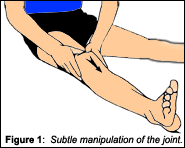
Stretching and passive motion. Muscle imbalance inhibits normal joint function and limits functional range of motion. In some knee conditions, improving the flexibility of shortened and tight muscles is necessary. Slow, sustained stretching, performed regularly and frequently, is effective, and can usually be started immediately, even in the early stages following an injury. Gentle, passive movement of the joint (Figure 1) also should be initiated soon after an injury to prevent the formation of adhesions, which make future rehab more difficult. If an injury is unusually acute (with joint effusion), an initial period of relative rest with cryotherapy is appropriate.
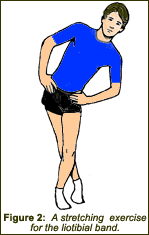
During this period, however, exercise of the opposite leg should be encouraged. Vigorous exercise of the uninvolved contralateral leg muscles produces a neurological stimulus in the injured muscles (called the "crossover effect"), and helps prevent atrophy.1
Three knee conditions, in particular, benefit from specific stretching. Iliotibial band syndrome is an overuse condition that causes pain along the lateral aspect of the knee. Ober's test is positive for a shortened iliotibial band and indicates the need for lengthening (Figure 2) of this long segment of connective tissue. Jumper's knee (or patellar tendinitis) and Osgood-Schlatter's disease are caused by repetitive excessive tension on the patellar tendon below the kneecap. When the tendon is attached to the still-open growth center at the tibial tuberosity, adolescents develop the characteristic swelling and bony disruption. Both conditions benefit from gentle, progressive stretching of the quadriceps muscle group and temporary avoidance of jumping and sprinting activities.
Isotonic resistance (open and closed chain). Weak or injured muscles can be strengthened rapidly with the use of isotonic resistance exercises. The resistance can come from a machine; weights; surgical-grade rubber tubing; or using the weight of the body. More important than the equipment used is whether the knee joint is exercised in an open- or closed-chain position. The knee is part of a closed kinetic chain when the foot is fixed (usually on the ground). The knee and leg are utilized in this fashion during most daily and sports activities, and require the co-contraction of accessory and stabilizing muscles. An open-chain exercise is done with the foot and lower leg moving freely. Both approaches to resistance exercise are useful, but one may be more appropriate for a certain knee problem than the other.
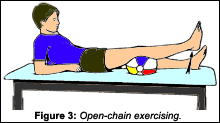
Open-chain exercising can be initiated early with a symptomatic knee, as it doesn't require the musculoskeletal structures to bear the weight of the body. Initial exercising (Figure 3) should be done with a limited amount of movement - from 30°( to full extension (called "terminal extension" exercises). These exercises are particularly useful for patients who have patellofemoral tracking problems, with symptoms traditionally described as chondromalacia patellae. Meniscal tears also are more safely exercised when the damaged cartilage is not bearing weight directly. As the patient progresses, additional resistance can be supplied safely with at-home equipment incorporating surgical-grade rubber tubing.
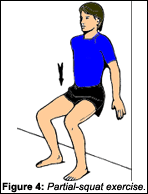
Closed-chain strengthening, with the foot on the floor, is considered a functional form of exercise. However, when ligaments have been damaged and there is joint translation and slipping, much caution must be taken initially. Injuries to the anterior cruciate or medial collateral ligaments respond well to resistance exercises that control knee joint alignment, by fixing the foot to the floor. Examples include partial squats (Figure 4), lunges and step-ups, or stairclimbing. Resistance can be increased progressively and gradually with the use of hand weights or a weight bar. The leg-press machine is another closed-chain exercise device available at many gyms; however, this machine does not retrain the co-contraction of accessory support muscles as fully as do weight-bearing exercises.
Eccentric exercise. When the injured tissue is a tendon, the eccentric portion of resistance exercising has been found to be particularly useful. This entails focusing on the lengthening or "negative" part of a strength exercise (the "letting down" of the weight or tubing). For the knee, this is performed most easily by descending a stair or stepping off a box (Figure 5). The contraction of the quadriceps muscles as they lengthen is particularly useful in strengthening the tendons involved in knee-extensor disorders, such as patellar tendinitis and patellar tracking problems.2 This movement also contracts other muscles, which must assist in the complex movements required of the knee. Specifically, the patient steps down onto the uninvolved leg, while controlling the movement with the quadriceps of the problem knee. The patient then returns by pushing back up with the uninvolved leg. Three sets of 10 step-downs are helpful when performed at least once a day.
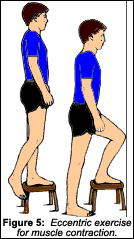
Proprioception and coordination. For many athletes (recreational or competitive), it is important to regain the fine neurological control necessary for accurate knee and lower-extremity movements. Approximately five to 10 minutes each day should be spent standing on one leg on a mini-trampoline, or using a specialized rocker board, with the eyes closed. The advantage of these balance exercises is seen when a patient returns to sports activities and can perform at high levels without consciously having to protect the knee. Rocker-board exercises are particularly necessary after ligament, meniscus, and muscle injuries, but also can help patients with chronic knee problems regain full function. Research has shown that custom-made orthotic support also can help improve balance and proprioception.3
Plyometric exercise. To re-establish the rapid responses necessary for ideal performance in many sports, advanced exercises designed to develop explosive power are necessary. Plyometric exercises include jumping with rapid returns, "bounding" style of running, or dropping off a box and quickly jumping up as high as possible. These types of exercises are useful during the final phase of rehab for all athletes who hope to return to full function after any type of knee problem. Sedentary patients, and those who do not need to develop this level of specialized contractions, generally do not need to progress to this specialized type of knee rehab.
Functional alignment. Many chronic and overuse knee problems develop secondary to imbalances in weight-bearing alignment of the lower extremities. These imbalances need to be addressed to resolve the patient's current symptoms and prevent future knee problems. In fact, measuring the Q-angle often demonstrates that patients with patellofemoral problems have underlying lower-extremity misalignments. Leg-length discrepancies and pronation problems frequently are associated with iliotibial band syndrome, patellar tracking problems, and chronic, degenerative knee complaints. Even anterior cruciate ligament ruptures have been found to be more common in athletes who have excessive pronation.4 The use of custom-made orthotics or heel lifts is often a necessary part of a comprehensive knee rehab program.5-7
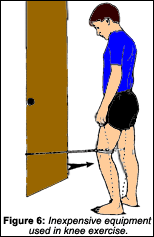
Shock absorption. For patients who already show evidence of degenerative changes to the joint surfaces, providing additional dispersion of ground reaction forces is necessary. Even healthy young athletes who expose their knees to frequent pounding (runners, basketball players, etc.) should be supplied with shock-absorbing insoles to decrease the stress transmitted from their feet to their knee joints. Many recreational athletes can avoid developing knee problems if they are fitted with custom-made orthotics that support the feet and ankles, and limit the forces on the knee joints. Shock-absorbing orthotics provide almost immediate symptom relief for patients with chronic, degenerative knee symptoms.8
Early Detection and Care
Instituting an appropriate and progressive rehab program is key to managing patients with knee complaints.9 Several rehab techniques are available, none of which require expensive equipment (Figure 6) or excessive time commitments. Selecting the best exercise approach for each patient's knee problem is important. A closely monitored home exercise program allows the doctor of chiropractic to provide cost-efficient, effective rehabilitative care.
Perhaps most critical in the long term is addressing any biomechanical alignment problems associated with knee complaints. This entails screening the patient for excessive pronation and leg-length discrepancies. Failure to recognize these complicating factors can result in a patient with recurring knee complaints, or possibly symptoms that vary in location. In other words, once an area is treated and strengthened, another will begin to show the effects of the underlying biomechanical stress. Once the lower extremities are aligned properly, the muscles strengthened and lengthened, and the two joints of the knee work smoothly, patients can enjoy the benefits of functional knee joints well into their elder years.
References
- Hertling D, Kessler RM. Management of Common Musculoskeletal Disorders (2nd ed.). Philadelphia: JB Lippincott, 1990:334.
- Souza TA. Differential Diagnosis for the Chiropractor: Protocols and Algorithms. Gaithersburg, Md.: Aspen Publishers, 1997:307.
- Stude DE, Brink DK. Effects of nine holes of simulated golf and orthotic intervention on balance and proprioception in experienced golfers. J Manip Physiol Ther 1997;20:590-601.
- Beckett ME, et al. Incidence of hyperpronation in the ACL injured knee: a clinical perspective. J Athl Train 1992;27:58-62.
- Souza TA. Treatment of common knee disorders: part II, specific conditions. Chiro Sports Med 1990; 4:119-127.
- Kuhn DR, Yochum TR, Cherry AR, Rodgers SS. Immediate changes in the quadriceps femoris angle after insertion of an orthotic device. J Manip Physiol Ther 2002;25(7):465-470.
- Christensen KD. Treating acute ACL ruptures. Dynamic Chiropractic 2000;18(3):28-29.
- Hyland JK. Musculoskeletal shock: causes and prevention. Practical Res Studies 2001;10(4):1-4.
- Kibler WB et al. Functional Rehabilitation of Sports and Musculoskeletal Injuries. Gaithersburg, Md.: Aspen Publishers, 1998:252.
Kim Christensen, DC, DACRB, CCSP, CSCS
Ridgefield, Washington



